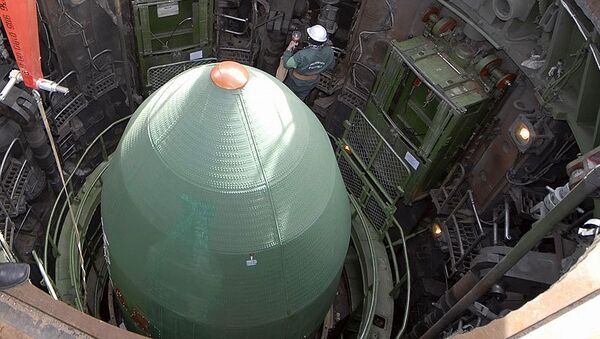MOSCOW, October 16 (RIA Novosti) – 50 years have passed since China tested its first nuclear device near Lake Lop Nur (Nor) in the country's northwestern Xinjiang Uygur Autonomous Region.
The atomic bomb was detonated on October 16, 1964 and on the same day the Chinese Government said that China would never be the first to use nuclear weapons.
Since the very inception of the People's Republic of China (PRC), national military-political leaders realized that the country should possess armed forces with modern weapons, including nuclear weapons.
The Chinese atomic project involved hundreds of Chinese nationals living abroad. After spending many years outside China, some of them came back and started taking part in the first stage of the atomic project. Scientists who were educated abroad and who had obtained practical experience brought many atomic secrets to China.
From 1937, Qian Senzhan, a postgraduate student from Beijing, studied at the Radium Institute (headed by Frederic Joliot Curie) of the University of Paris. After defending his thesis and working in France, he returned to China in 1948. In early 1950, he was appointed Deputy Director of the Institute of Modern Physics affiliated with the Chinese Academy of Sciences.
China decided to implement its own atomic bomb project after Zhu De, the Vice President of the PRC, Defense Minister Peng Dehuai and other high-ranking Chinese military leaders watched the September 14, 1954 Soviet military exercise involving a nuclear explosion in the Totskoye training area.
That same year, Mao Zedong, Chairman of the Communist Party of China, asked Nikita Khrushchev, the First Secretary of the Communist Party of the Soviet Union, to disclose the secrets of the atomic bomb and to help manufacture the weapons in China.
Khrushchev declined Mao's request and advised the Chinese leader not to implement any atomic projects because China lacked the required scientific and industrial potential and financial resources, but he promised to assist Beijing in its civilian nuclear program.
At that time, the USSR assisted the PRC in its nuclear energy and nuclear physics research projects. From 1955 to 1958, six bilateral agreements were signed, and numerous Chinese nuclear physicists began to study at the Joint Institute for Nuclear Research located in the Russian town of Dubna.
In January 1955, Chinese leaders decided to develop their own nuclear weapons. A relevant development program was adopted, and a specialized ministry was established.
The situation changed in 1957. Khrushchev was forced to expand cooperation with China because he needed political support against the background of a struggle against the so-called "Anti-Party Group" comprising Vyacheslav Molotov, Kliment Voroshilov, Georgy Malenkov and other die-hard Stalinists. As a result, Beijing received access to Soviet nuclear weapons technology.
On October 15, 1957, the USSR agreed to sign a new agreement on defense technologies and to provide China with atomic bomb samples and technical data for manufacturing purposes.
However, bilateral relations eventually worsened, and Moscow told Beijing that it would no longer supply technical data on the atomic bomb project to China. In 1959, data transfers were reduced sharply, and in 1960, Soviet nuclear specialists were called back from China. But this measure did little to delay the development of the first Chinese nuclear device.
By that time, China had already trained about 6,000 national specialists with Soviet assistance. Beijing already possessed various theoretical data obtained from the USSR and continued to receive detailed reports through a ramified network of its European contacts, including numerous scientists and engineers sympathizing with China.
The Chinese nuclear weapons project included about 900 academic and industrial organizations supervised by the Second Ministry of Machine-Building.
The atomic bomb project lasted five years, rather than eight, as initially planned.
On October 16, 1964, China detonated its first nuclear device suspended from a steel tower. The explosion made China the fifth nuclear power in the world.
According to Western experts, the Chinese nuclear program cost an estimated $4.1 billion.
On May 14, 1965, the first Chinese atomic bomb exploded after being dropped from a bomber. On June 17, 1967, China tested its first thermonuclear (hydrogen) bomb. On December 27, 1968, Beijing tested a thermonuclear warhead containing weapons-grade plutonium for the first time.
On September 23, 1969, China conducted its first underground nuclear test. On October 16, 1980, China conducted its last atmospheric nuclear test and later started detonating nuclear devices underground. The last Chinese nuclear test was conducted on July 29, 1996.
In all, the PRC has conducted 47 nuclear tests, including 23 atmospheric tests. Three nuclear devices were suspended from towers, and two of them were detonated 102 meters above the ground. All nuclear tests were conducted at the Lop Nur Nuclear Testing Site in northwestern China.
On August 1, 1996, China announced a moratorium on all nuclear testing and later signed the Comprehensive Nuclear Test Ban Treaty (CTBT).
In 2007, the Chinese Government turned its Lop Nur Nuclear Testing Site into a tourist site.



